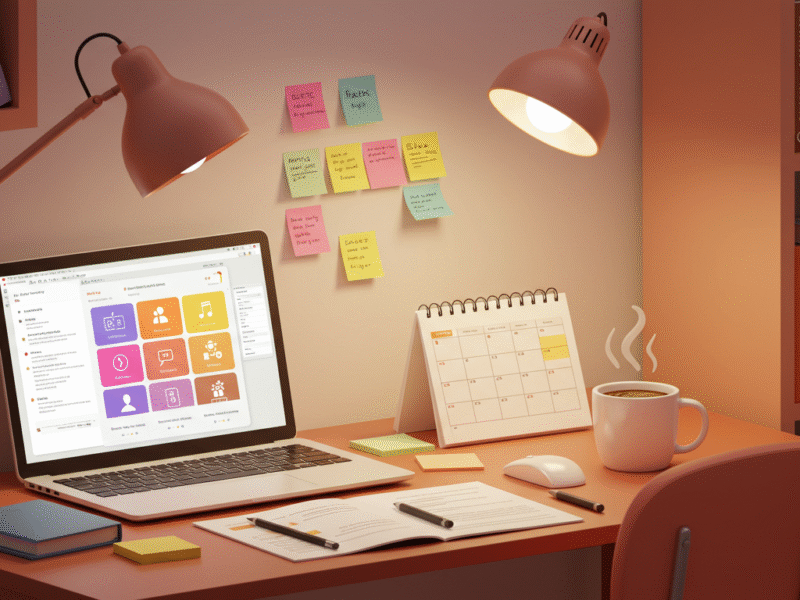Ever stared at your textbook for hours, only to end up scrolling through social media instead, wondering where the day went? As a student, procrastination can feel like that sneaky friend who always talks you into skipping the gym – fun in the moment, but regrettable later. It’s a common trap that hits millions of us, turning simple assignments into last-minute marathons. But here’s the good news: overcoming procrastination isn’t about superhuman willpower; it’s about smart strategies that fit into your busy life. In this guide, we’ll dive into practical ways to beat it, from understanding why it happens to building habits that stick. Whether you’re in high school, college, or grad school, these tips can help you reclaim your time and boost your grades without the stress.
What Exactly Is Procrastination and Why Do Students Fall Into It?
Let’s start by getting clear on what procrastination really means. It’s not just laziness – that’s a myth. Procrastination is when you delay tasks you know you should do, often replacing them with less important activities. For students, this might mean putting off studying for a big exam until the night before, even though you feel guilty about it the whole time.
Why does this happen so often to students? Life as a learner is packed with pressures. You’ve got classes, homework, extracurriculars, maybe a part-time job, and social life on top. Your brain gets overwhelmed, and procrastination becomes a way to escape that overload temporarily. Psychologists say it’s linked to how our minds handle rewards. Immediate pleasures, like watching a funny video, feel better than the delayed payoff of acing a test. Plus, fear of failure plays a big role – if you’re worried about not doing something perfectly, it’s easier to avoid starting altogether.
Think about it: in a world of constant distractions like notifications pinging every minute, staying focused is tougher than ever. Studies show that the average student procrastinates on about 30-40% of their tasks, leading to lower performance and higher stress levels. But recognizing this is the first step. Once you see procrastination as a habit, not a character flaw, you can start changing it.
Read Also:
Common Causes of Procrastination Among Students
To tackle procrastination head-on, you need to know its roots. Every student is different, but some triggers are pretty universal.
First up, poor time management skills. If you’re not great at estimating how long tasks take, everything piles up. You might think, “Oh, that essay will only take an hour,” but it drags on for three, leaving you scrambling.
Then there’s perfectionism. Many high-achieving students set impossibly high standards. The thought of turning in something less than flawless makes starting scary. It’s like staring at a blank page, waiting for inspiration that never comes.
Distractions are another biggie. Your phone, roommates chatting, or even background noise can pull you away. In today’s digital age, apps are designed to hook you – endless feeds that make it hard to log off.
Lack of motivation hits hard too, especially for subjects that don’t excite you. If math feels like a chore, it’s tempting to push it aside for something fun.
Finally, burnout from overloaded schedules. Students often juggle too much, leading to exhaustion where even simple tasks feel monumental. Emotional factors like anxiety or depression can amplify this, making procrastination a coping mechanism.
By pinpointing your personal causes, you can tailor your approach. Maybe track your day for a week to spot patterns – when do you procrastinate most? Mornings? Evenings? Awareness is key to breaking the cycle.
The Real Impact of Procrastination on Student Life
Procrastination might seem harmless at first – what’s one skipped study session? But over time, it adds up to some serious consequences.
Academically, it tanks your grades. Rushed work is rarely your best, leading to mistakes and shallow understanding. Research from universities shows chronic procrastinators have GPAs up to 0.5 points lower than their peers.
Health-wise, it’s a stressor. That all-nighter buzz? It’s followed by crashes in energy, poor sleep, and weakened immunity. Constant guilt and anxiety can even lead to mental health issues like depression.
Socially, it strains relationships. Blowing off group projects means letting teammates down, or missing out on fun because you’re catching up on work.
Long-term, it builds bad habits that spill into careers. Employers value reliability, and procrastination erodes that. Plus, it robs you of personal growth – imagine the skills you’d gain if you tackled challenges head-on.
But flip it around: overcoming this boosts confidence. You feel in control, enjoy free time guilt-free, and achieve more. It’s not about being perfect; it’s about progress that makes student life enjoyable.
Building a Strong Foundation: Mindset Shifts to Beat Procrastination
Changing how you think about tasks is crucial. Start with self-compassion. Beating yourself up only makes it worse. Instead, treat yourself like a friend – “Hey, it’s okay, let’s try again.”
Adopt a growth mindset. View challenges as chances to learn, not threats. Carol Dweck’s research shows this attitude reduces avoidance behaviors.
Reframe tasks positively. Instead of “I have to study,” say “I get to learn something new.” This small shift makes starting easier.
Visualize success. Picture finishing that assignment and feeling relieved – it motivates action.
Finally, forgive past slips. Holding onto guilt keeps you stuck. Each day is a fresh start to build better habits.
Effective Time Management Techniques for Students
Time management is your secret weapon against procrastination. Let’s break down some proven methods.
The Pomodoro Technique is a favorite. Work for 25 minutes straight, then take a 5-minute break. After four cycles, a longer break. It builds focus without burnout. Apps like Focus Booster make it easy to track.
Time blocking schedules your day in chunks. Assign specific times for studying, eating, relaxing. This creates structure, reducing decision fatigue.
Prioritize with the Eisenhower Matrix. Sort tasks by urgent/important. Do important ones first, delegate or delete the rest.
Use to-do lists wisely. Break big tasks into tiny steps – “Research topic” instead of “Write paper.” Cross off items for that dopamine hit.
Weekly planning helps too. Sunday evenings, map out the week. Adjust as needed, but having a plan cuts overwhelm.
Remember, flexibility is key. Life happens, so don’t be rigid. These techniques turn chaotic days into productive ones.
Setting Realistic Goals to Stay Motivated
Goals give direction, but they must be smart to work.
Use SMART criteria: Specific, Measurable, Achievable, Relevant, Time-bound. Instead of “Study more,” say “Read 20 pages of history by 5 PM today.”
Break long-term goals into milestones. Preparing for finals? Set weekly targets like “Finish chapter reviews by Friday.”
Reward yourself. After completing a goal, treat yourself – coffee, a walk, or an episode of your show. It reinforces positive behavior.
Track progress visually. A habit tracker app or calendar with stickers shows streaks, motivating consistency.
Adjust goals if needed. If something’s too ambitious, scale back to avoid discouragement.
Motivation fluctuates, so pair goals with accountability. Tell a friend your plans – their check-ins keep you on track.
Creating the Perfect Study Environment
Your space influences productivity hugely. Optimize it to minimize distractions.
Choose a dedicated spot. Desk in a quiet room, not your bed – that signals relaxation.
Keep it organized. Clutter distracts; tidy surfaces help focus.
Lighting matters. Natural light boosts mood; desk lamps reduce eye strain.
Control noise. White noise apps or headphones block distractions.
Limit tech temptations. Use site blockers like Freedom to restrict social media during study time.
Personalize mildly. Plants or motivational posters add positivity without overwhelming.
Ergonomics count too. Comfortable chair prevents discomfort that leads to breaks.
Experiment – what works for one might not for another. A good environment makes starting easier.
Developing Habits That Stick
Habits automate good behavior, reducing reliance on willpower.
Start small. Habit stacking: Pair new habits with existing ones, like reviewing notes after breakfast.
Consistency over intensity. Study 15 minutes daily rather than cramming.
Use cues. Set phone reminders or leave books out as visual prompts.
Track habits. Apps like Habitica gamify it, making it fun.
Handle slip-ups. Miss a day? Jump back in without self-judgment.
Build routines. Morning rituals set a productive tone for the day.
Over time, these become automatic, making procrastination rare.
Leveraging Tools and Apps for Productivity
Tech can be an ally, not just a distraction.
For task management, try Todoist or Microsoft To Do – simple lists with reminders.
Focus apps like Forest plant virtual trees as you work; distractions kill them.
Note-taking: Evernote or Notion organize thoughts efficiently.
Calendar apps: Google Calendar syncs schedules across devices.
Pomodoro timers: Tomato Timer keeps sessions on track.
Accountability apps: StickK lets you bet on goals.
Choose a few – too many overwhelm. Integrate them into your routine for max benefit.
Boosting Motivation Through Rewards and Accountability
Motivation isn’t constant; fuel it strategically.
Self-rewards work wonders. Finish homework? Enjoy ice cream.
Accountability partners: Study buddies or online forums where you share progress.
Public commitments: Post goals on social media – pressure motivates.
Gamification: Apps turn tasks into games with points and levels.
Inspiration sources: Read success stories or watch TED Talks on productivity.
Variety: Mix study methods – videos, quizzes – to keep it fresh.
When motivation dips, remember your “why” – better grades, dream job, personal pride.
Handling Distractions in a Digital World
Distractions are everywhere; manage them proactively.
Phone habits: Do Not Disturb mode during study; check at breaks.
Browser extensions: StayFocusd limits time on sites.
Multitasking myth: Focus on one thing – it’s more efficient.
Mindful breaks: Walk or stretch instead of scrolling.
Environment tweaks: Study away from temptations.
Track distractions: Journal what pulls you away to address root causes.
Over time, discipline builds, making focus natural.
The Role of Nutrition, Exercise, and Sleep in Overcoming Procrastination
Physical health underpins mental sharpness.
Sleep: Aim for 7-9 hours. Poor sleep impairs focus, worsening procrastination.
Nutrition: Balanced meals fuel energy. Avoid sugar crashes; opt for proteins, veggies.
Exercise: 30 minutes daily releases endorphins, reducing stress.
Hydration: Dehydration fogs the brain – drink water regularly.
Routines: Consistent bedtimes, meal preps support steady energy.
Small changes yield big results – feel more alert, less prone to delay.
Mindfulness and Stress Management Techniques
Mindfulness calms the mind, curbing impulsive avoidance.
Meditation apps: Headspace offers student-friendly sessions.
Breathing exercises: 4-7-8 technique – inhale 4, hold 7, exhale 8 – reduces anxiety.
Journaling: Write worries to clear mental space.
Progressive relaxation: Tense and release muscles to unwind.
Yoga: Combines movement and mindfulness for dual benefits.
Daily practice builds resilience against procrastination triggers.
Seeking Support: When to Talk to Friends, Family, or Professionals
You don’t have to go it alone.
Friends: Share struggles – they might relate and offer tips.
Family: Their encouragement provides external motivation.
Study groups: Collective focus keeps everyone accountable.
Counselors: School resources help with underlying issues like anxiety.
Online communities: Reddit’s r/GetMotivated or student forums.
Know when it’s deeper: If procrastination affects daily life, seek professional help.
Support networks make the journey easier and more sustainable.
Real-Life Student Stories: Overcoming Procrastination Successes
Hearing from others inspires. Take Sarah, a college sophomore. She procrastinated on essays until deadlines loomed. By using Pomodoro and breaking tasks down, she finished early, improving her GPA and sleep.
Or Mike, a high schooler buried in homework. Time blocking helped him balance sports and studies, reducing stress.
Then there’s Lena, who battled perfectionism. Mindfulness apps taught her to start imperfectly, leading to consistent progress.
These stories show it’s doable – real people, real changes.
Common Pitfalls and How to Avoid Them
Even with plans, slip-ups happen. Avoid overcommitting: Start with few changes.
Ignore all-or-nothing thinking: Partial progress counts.
Don’t ignore burnout: Schedule rest days.
Resist comparison: Your pace is yours.
If a method fails, switch – flexibility is key.
Stay patient: Habits take time, often 21-66 days.
Long-Term Strategies for a Procrastination-Free Life
Beyond student years, these skills last.
Continuous learning: Read books like “Atomic Habits” by James Clear.
Reflect regularly: Monthly reviews of what’s working.
Adapt to changes: New semesters bring new challenges – adjust accordingly.
Build resilience: View setbacks as lessons.
Foster curiosity: Enjoy learning to reduce avoidance.
These lay foundations for lifelong productivity.
Wrapping It Up: Your Path to Productivity
Overcoming procrastination as a student is a journey, not a sprint. Start small, be kind to yourself, and use these strategies to build momentum. You’ll find more time for what you love, less stress, and better results. Remember, every successful person faced this – you’re in good company.
For more tips on student productivity, check out this helpful resource: Edutopia’s Guide to Student Motivation.
If you’re interested in apps that can help, explore: Todoist for Task Management.











